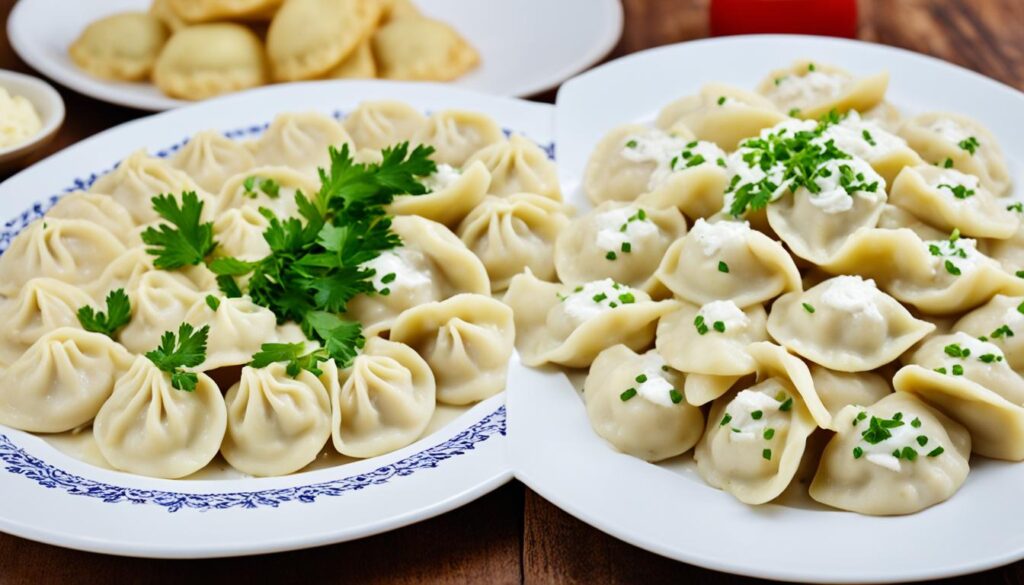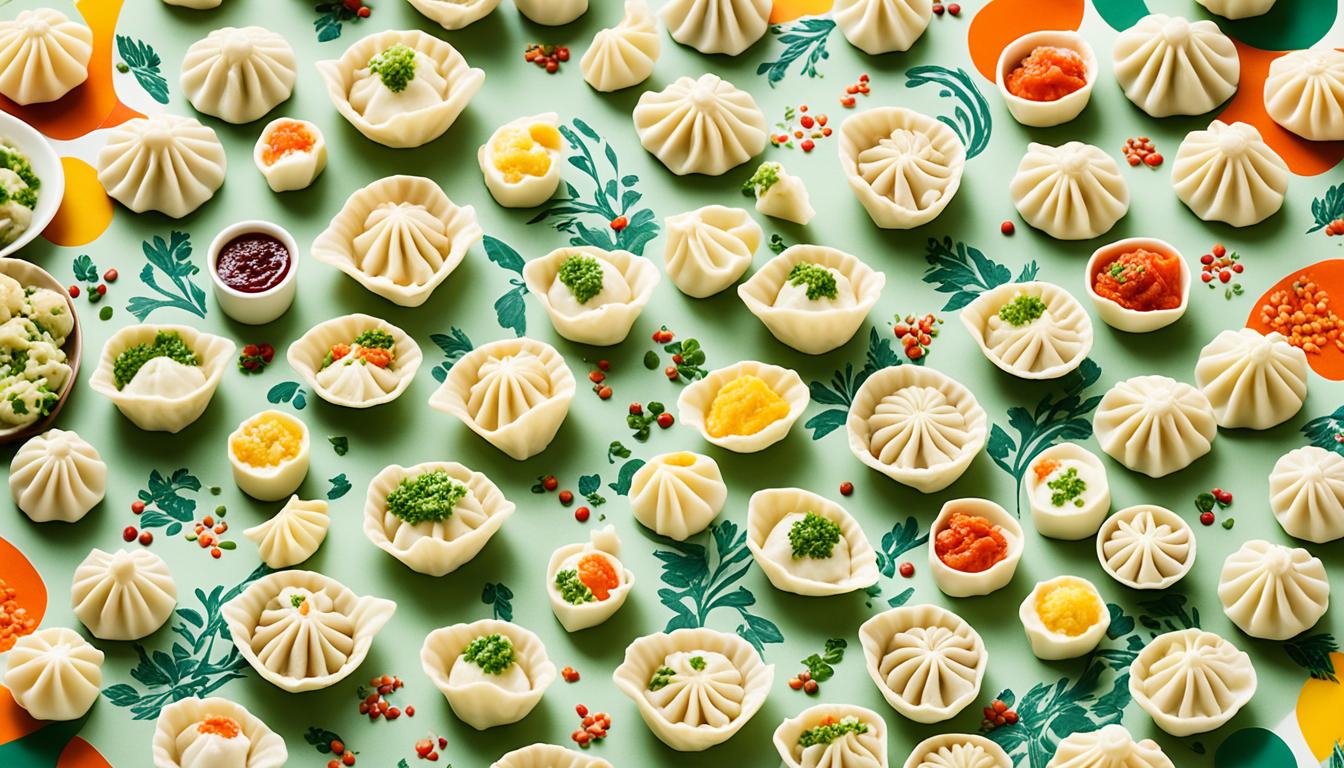Welcome to our global guide on dumpling types around the world! Dumplings are a beloved comfort food enjoyed by people from different cultures and cuisines. Did you know that there are countless varieties of dumplings, each with their own unique style, flavors, and cooking methods? From the traditional Chinese jiaozi to the Turkish manti, dumplings have made their way into the culinary hearts of millions.
So, are you ready to embark on a mouthwatering journey around the globe to explore the diverse and delicious world of dumplings? Get ready to discover the international dumplings that have captured the hearts and taste buds of people all over the world. From homemade dumpling dishes to popular dumplings in diverse cultures, we’ve got you covered. Let’s dive in and satisfy our dumpling cravings!
Chinese Dumplings: Crescent-Shaped Varieties
Chinese dumplings are a culinary treasure, offering a diverse range of flavors, fillings, and cooking techniques. Among the many delightful shapes, crescent-shaped dumplings stand out as a quintessential representation of Chinese dumpling culture.
Also known as “jiaozi,” crescent-shaped Chinese dumplings are named for their distinctive half-moon shape. These dumplings are made by folding a thin, round circle of dough around a flavorful filling and pleating or crimping the edges together, creating a seal that locks in the delicious ingredients.
Chinese dumplings hold a significant cultural and culinary importance. In fact, China is often referred to as the “dumpling capital of the world,” showcasing a vast array of mouthwatering options. Whether you’re exploring the bustling streets of Shanghai or Beijing, you’ll find dumpling vendors serving up these savory delights.
Chinese dumplings can be prepared using various types of dough, fillings, and cooking methods. Let’s take a closer look at some popular variations:
Gao
Gao dumplings are made with a soft, tender dough that is carefully pleated and folded to form small, delicate packages. These dumplings are commonly steamed, resulting in a light and fluffy texture that is perfect for enjoying the flavorful fillings.
Jiao
Jiao dumplings feature a slightly thicker dough and a heartier filling. They are often boiled, creating a dumpling that is satisfyingly chewy and bursting with delicious flavors. Jiao dumplings are a popular choice during the festive Chinese New Year celebrations.
Buns
In addition to the crescent-shaped dumplings, China is also famous for its savory buns, known as “baozi” or simply “buns.” These buns are made with a fluffy, steamed bread dough that encases a wide range of delectable fillings, such as pork, beef, vegetables, and even sweet fillings for dessert buns.
Chinese dumplings offer a rich tapestry of flavors and culinary traditions. From traditional pork and cabbage fillings to creative combinations like shrimp, pork, and peanuts in chiu-chao fun gow, there is a dumpling to suit every palate.
Chinese Dumpling Cooking Methods:
- Steaming: Steaming is a common cooking method for Chinese dumplings, resulting in tender, moist dumplings with a soft, thin skin.
- Boiling: Boiled dumplings have a heartier texture and a satisfying chewiness. They are commonly served with dipping sauces.
- Pan-Frying: Pan-fried dumplings, also known as potstickers or guo tie, are crispy on the bottom and tender on the top. They offer a delightful contrast of textures.
- Deep-Frying: Deep-fried dumplings are crispy and golden on the outside, with a juicy filling inside. This cooking method adds an extra layer of indulgence to the dumpling experience.
Chinese dumplings are not only delicious but also a celebration of culture, tradition, and togetherness. Whether enjoyed at home with family or savored at a bustling street food market, these crescent-shaped delights never fail to captivate and satisfy.
Chinese Dumplings: Purse-Shaped Varieties
Another type of Chinese dumpling is purse-shaped, formed with a round of dough that is pleated and drawn towards the top of the fillings like a drawstring purse. These dumplings are often compared to bready steamed buns but with thinner wrappers. Common varieties include jiu cai bau (chive dumplings), xiao long bao (soup dumplings), sheng jian bao (fried soup dumplings), and siu mai (open-topped pork and/or shrimp dumplings).
Comparison between Chinese Dumpling Types
| Chinese Dumpling Types | Shape | Wrapper Thickness | Filling | Cooking Methods |
|---|---|---|---|---|
| Jiaozi | Crescent-shaped | Thin | Various | Boiled, Steamed, Pan-fried, Deep-fried |
| Baozi | Purse-shaped | Thicker | Various | Steamed |
Top 5 Chinese Purse-Shaped Dumplings
- Jiu Cai Bau: Chive dumplings with a flavorful filling of chives, mushrooms, and sometimes pork.
- Xiao Long Bao: Soup dumplings filled with seasoned meat and a rich, savory broth.
- Sheng Jian Bao: Fried soup dumplings with a crispy bottom and a juicy meat filling.
- Siu Mai: Open-topped dumplings with a mix of ground pork, shrimp, and other flavorful ingredients.
These purse-shaped dumplings are a popular choice for dim sum and are enjoyed for their unique textures and delicious fillings. Whether steamed, fried, or enjoyed in a soup, Chinese purse-shaped dumplings are a delightful culinary experience.
Korean Mandu
In Korean cuisine, mandu is a popular type of dumpling that can be divided into two distinct categories. The first category of mandu bears resemblance to Chinese jiaozi and Japanese gyōza, featuring a crescent-shaped design. These dumplings are made by folding a thin, round circle of dough around a filling and pleating or crimping the edges together. The second category of mandu is similar to the bun-type manti found in Central Asia.
Mandu can be prepared using various cooking methods such as steaming, boiling, or frying. The fillings for mandu are diverse and can include ingredients such as tofu, beef, kimchi, or local vegetables, offering a range of flavors and textures. Some popular varieties of mandu include wang mandu, pyeonsu, eo-mandu, seongnyu-mandu, gyuasang, and kimchi-mandu.
| Mandu Variety | Description |
|---|---|
| Wang Mandu | A large steamed mandu filled with a combination of minced meat, vegetables, and sometimes noodles |
| Pyeonsu | Small mandu with a thin translucent wrapper, usually filled with meat and lightly pan-fried |
| Eo-mandu | Dumplings filled with fish, typically steamed or boiled |
| Seongnyu-mandu | Mandu filled with fresh vegetables, typically served in a clear broth |
| Gyuasang | Steamed mandu filled with seasoned minced beef and vegetables |
| Kimchi-mandu | Dumplings with a spicy kimchi-based filling, often pan-fried |
Japanese Gyoza
Gyoza is the Japanese version of the Chinese potsticker dumpling. It was introduced to Japan by soldiers who fell in love with the dumplings while stationed in China during World War II. Gyoza has a thinner skin compared to its Chinese counterpart and is known for its rich garlic flavor. It is typically filled with a mixture of minced pork, cabbage, and shiitake mushrooms.
Gyoza is often served crispy, thanks to the use of machine-made wrappers, and can be pan-fried, steamed, or boiled.
Japanese Gyoza vs. Chinese Potstickers
“Gyoza in Japan is similar to the potstickers in China, but there are a few key differences. While both are filled dumplings, gyoza has a thinner and almost translucent skin compared to the slightly thicker and more doughy potsticker wrapper. Additionally, gyoza is known for its garlic flavor, while potstickers are typically filled with a mixture of meat and cabbage. Both are delicious in their own right, but the slight variations make them distinct.”
| Chinese Dumplings (Potstickers) | Japanese Gyoza |
|---|---|
| Pleated and crimped edges | Pleated edges |
| Thicker dough wrapper | Thin, translucent wrapper |
| Various fillings (meat, seafood, vegetable) | Minced pork, cabbage, shiitake mushrooms |
| Pan-fried, steamed, or boiled | Pan-fried, steamed, or boiled |
Indian and Nepali Momos
Momos are a beloved dish in northern Indian, Nepali, and Tibetan cuisines. These dumplings, resembling Chinese baozi in shape, have been influenced by the vibrant Indian spices and herbs. Momos are typically filled with a delicious combination of ground meat and vegetables, creating a perfect blend of flavors. They are then steamed to perfection, resulting in tender and juicy dumplings that are sure to delight your taste buds.
One of the distinguishing features of momos is the tomato-based dipping sauce that accompanies them, adding an extra burst of tanginess to each bite.
Variations of momos can be found across these regions, each with its own unique touch. From different fillings to alternative cooking methods, there is a world of momo varieties to explore. Whether you prefer vegetarian momos filled with tofu and vegetables, or the classic meat-filled ones, there is a momo for every palate.
When it comes to cooking methods, steaming is the most popular and traditional way of preparing momos, as it helps preserve the flavors of the fillings. However, pan-frying and deep-frying methods can also be used to achieve a crispy texture and enhance the flavors even further.
If you’re curious about the origins and cultural significance of momos, Tibetan cuisine also boasts its own unique version of momos, with variations in fillings and cooking methods.
For those craving a delicious and satisfying dumpling experience, Indian and Nepali momos are a must-try. Their fusion of Indian and Tibetan flavors, along with the wide array of fillings and cooking methods, makes momos a true culinary delight.
Russian Pelmeni and Polish Pierogi
In Russia, pelmeni is a meat lover’s delight, featuring fillings of beef, lamb, pork, or venison. They are boiled dumplings with a round, shell-shaped appearance.
In Poland, pierogi are widely celebrated and can be fried or boiled. They are stuffed with various fillings, including meat, potato, sauerkraut, and sweet ingredients.
Both pelmeni and pierogi are versatile and can be enjoyed as a main dish or side dish.
Check out the visual representation of Russian pelmeni and Polish pierogi:

Turkish Manti and Italian Filled Pasta
In our delicious journey around the world of dumplings, we now take a savory detour to explore two beloved culinary traditions: Turkish manti and Italian filled pasta.
Turkish manti are small dumplings filled with flavorful ground meat and served with a delectable combination of yogurt, garlic, and melted butter. These tiny pockets of culinary delight are typically boiled, resulting in tender yet satisfying dumplings. For an alternative preparation method, manti can also be baked, adding a delightful crispness to the dish.
Meanwhile, in Italy, filled pasta takes center stage with its various incarnations such as ravioli, tortellini, and agnolotti. These pasta marvels are crafted by encasing a delicious mixture of ground meat, cheese, and other ingredients within delicate pasta sheets. When it comes to cooking, these Italian filled pasta dishes offer versatility, as they can be enjoyed either by boiling or baking, depending on personal preference.
From the exquisite delights of Turkish manti to the diverse world of Italian filled pasta, these culinary gems showcase the artistry and creativity that go into crafting dumplings around the world. Whether you savor the rich flavors of manti or indulge in the intricate pasta creations of Italian cuisine, these unique dumpling varieties are sure to tantalize your taste buds.
